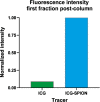Advancing intraoperative magnetic tracing using 3D freehand magnetic particle imaging
- PMID: 34333740
- PMCID: PMC8738628
- DOI: 10.1007/s11548-021-02458-2
Advancing intraoperative magnetic tracing using 3D freehand magnetic particle imaging
Abstract
Purpose: Sentinel lymph node biopsy is a routine procedure for nodal staging in penile cancer. Most commonly, this procedure is guided by radioactive tracers, providing various forms of preoperative and intraoperative guidance. This is further extended with fluorescence imaging using hybrid radioactive-fluorescence tracers. Alternatively, a magnetic-based approach has become available using superparamagnetic iron-oxide nanoparticles (SPIONs). This study investigates a novel freehand magnetic particle imaging and navigation modality (fhMPI) for intraoperative localization, along with a hybrid approach, combining magnetic and fluorescence guidance.
Materials and methods: The fhMPI set-up was built with a surgical navigation device, optical tracking system and magnetometer probe. A dedicated reconstruction software based on a look-up-table method was used to reconstruct a superficial 3D volume of the SPION distribution in tissue. For fluorescence guidance, indocyanine green (ICG) was added to the SPIONs. The fhMPI modality was characterized in phantoms, ex vivo human skin and in vivo porcine surgery.
Results: Phantom and human skin explants illustrated that the current fhMPI modality had a sensitivity of 2.2 × 10-2 mg/mL SPIONs, a resolving power of at least 7 mm and a depth penetration up to 1.5 cm. Evaluation during porcine surgery showed that fhMPI allowed for an augmented reality image overlay of the tracer distribution in tissue, as well as 3D virtual navigation. Besides, using the hybrid approach, fluorescence imaging provided a visual confirmation of localized nodes.
Conclusion: fhMPI is feasible in vivo, providing 3D imaging and navigation for magnetic nanoparticles in the operating room, expanding the guidance possibilities during magnetic sentinel lymph node procedures. Furthermore, the integration of ICG provides the ability to visually refine and confirm correct localization. Further clinical evaluation should verify these findings in human patients as well.
Keywords: Augmented reality; Fluorescence-guided surgery; Magnetic particle-guided surgery; Penile cancer; Surgical navigation.
© 2021. The Author(s).
Conflict of interest statement
During this research, GR and FvL were (partially) affiliated with ORSI Academy. The authors declare that they have no further conflicts of interest.
Figures





References
-
- Zeidman I, Buss JM. Experimental studies on the spread of cancer in the lymphatic system: I. Effectiveness of the lymph node as a barrier to the passage of embolic tumor cells. Cancer Res. 1954;14(5):403–405. - PubMed
-
- Wawroschek F, Wagner T, Hamm M, Weckermann D, Vogt H, Märkl B, Gordijn R, Harzmann R. The influence of serial sections, immunohistochemistry, and extension of pelvic lymph node dissection on the lymph node status in clinically localized prostate cancer. Eur Urol. 2003;43(2):132–137. doi: 10.1016/S0302-2838(02)00450-5. - DOI - PubMed
-
- Hakenberg O, Compérat E, Minhas S, Necchi A, Protzel C, Watkin N (2020) EAU guidelines on penile cancer. In: EAU guidelines. EAU Annual Congress Amsterdam - PubMed
MeSH terms
Substances
Grants and funding
LinkOut - more resources
Full Text Sources

